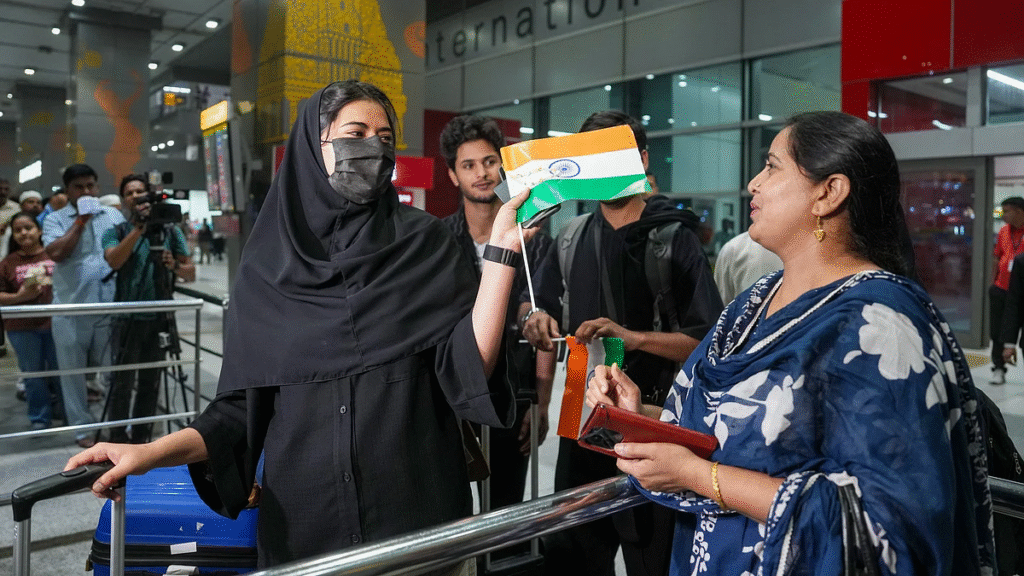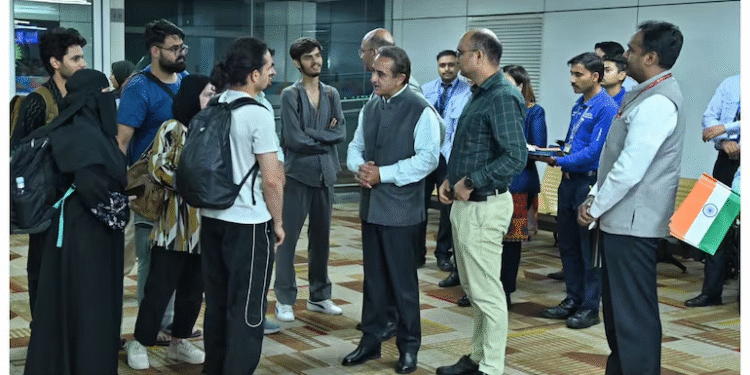Over 100 Indian students evacuated from conflict-hit Iran landed in Delhi early Thursday morning. Many expressed gratitude for their safe return and shared their fears during the conflict
As tensions between Israel and Iran have intensified, the Indian Embassy coordinated the relocation of 110 Indian students from Tehran to Armenia by land on Tuesday as part of ‘Operation Sindhu‘. The students later departed from Armenia’s capital, Yerevan and arrived in New Delhi early Thursday morning on the first evacuation flight.
After landing in Delhi, several students expressed gratitude to the Indian government for facilitating their return amidst fears during the conflict, while some explained the growing tensions in the region.
One of the students evacuated from Iran told ANI, “I am happy that I am back to our country. We didn’t see any such thing in Urmia, but in other places across Iran, the situation was bad… The Government of India helped a lot, which is why we are back home.”

Another student added, “I am a final year MBBS student at Urmia University… We saw drones and missiles. We were scared… We are happy to return to India and are very thankful to the government of India, especially the Ministry of External Affairs… Our parents were also worried, but now they are happy.”
Yasir Gaffar, an Indian evacuated from Iran, said, “We saw the missiles passing by and the loud sounds at night… I am happy to reach India… I haven’t given up on my dreams… When the situation improves, we will return to Iran.”
Expressing gratitude, Mariam Roz, a student from Iran, said, “The Indian Embassy had already prepared everything for us. We did not face any issues. We are travelling for three days, so we are tired… The situation was not so bad in Urmia when we left. We would see missiles from the windows of our dorm.”
Another student added, “I am very happy. I cannot express in words how happy I am to be finally able to meet my family. The situation in Iran is very bad. The people there are like us; there are small children who are suffering. War is not a good thing. It kills humanity.”
As the Iran-Israel conflict flared into a full-scale confrontation, hundreds of Indian students found themselves caught in the crossfire of what many are now calling one of the most dangerous escalations in the region in years.
For 72 hours, these young students lived through sirens, missile strikes, and the constant threat of drone attacks before being safely evacuated. Their stories paint a harrowing picture of fear, uncertainty, and survival in a foreign land turned battlefield.
The crisis began escalating rapidly when a series of missile strikes were launched between Iran and Israel, retaliating for previous covert operations and cyberattacks. What initially seemed like a political standoff turned into a military exchange within hours. With airspace compromised and communication networks destabilized, panic gripped major cities in Iran, especially those near strategic military and nuclear sites.
For Indian students studying in Tehran, Shiraz, and Isfahan, the threat wasn’t just a headline—it was unfolding outside their windows.
Riya Mehta, a 21-year-old medical student from Delhi studying in Tehran, described the chilling moment she realized the city was under attack.
“We heard sirens first—very loud and urgent. Then the internet started glitching. A few minutes later, we saw something explode in the distance. Drones, missiles—it was all real. The city plunged into fear,” she said.
Similarly, Rajat Sharma, a 23-year-old engineering student, recalled how he and his friends spent two nights hiding in underground bunkers provided by their university.

“We didn’t sleep for two days. Every time we heard a rumble in the sky, we thought it was coming for us. We barely ate, barely breathed.”
As the conflict escalated, students rushed to contact the Indian Embassy. Thousands of calls flooded the lines. Many parents back home in India took to social media, tagging the Ministry of External Affairs (MEA) and External Affairs Minister Dr. S. Jaishankar, pleading for swift action.
By the second day of the conflict, the Indian government activated emergency protocols. Special charter flights were planned in coordination with neighboring countries, and students were told to remain in secure shelters until further notice.
In a remarkable show of diplomacy and logistics, the Indian government launched “Operation Safe Return,” deploying aircraft to evacuate more than 300 Indian students within 48 hours. The operation was carried out in collaboration with UAE and Oman, with airspace routes carefully mapped to avoid active war zones.
Footage from Tehran Airport showed students boarding Indian Air Force planes, visibly shaken but relieved. Some clutched their passports and Indian flags, others were seen breaking down in tears after boarding.
A MEA official stated,
“Our priority was the safety of every Indian citizen. We were in constant touch with embassies, universities, and local contacts to coordinate extraction. It was a race against time.”
Back in India, families received their loved ones at airports with tearful hugs and gratitude. Many of the returning students are now speaking out—not just about their trauma but also about the need for better contingency protocols in conflict zones.
Sania Qureshi, who returned to Mumbai, said:
“I’m thankful to be alive. But I want to ask—why were we not alerted earlier? We should have been evacuated before the first missile was fired.”
Other students are calling for universities abroad to have mandatory war-time protocols, including food reserves, shelter maps, and embassy helplines. Many have said they will not return to Iran to complete their studies until the region stabilizes.This incident has brought renewed attention to the vulnerability of Indian nationals—especially students—in conflict-prone regions. With over 20,000 Indian students studying across the Middle East, the government may now be pushed to develop a permanent emergency framework that can be activated within hours, similar to Israel’s Iron Dome or Japan’s disaster alert systems.
Analysts also believe that countries like Iran and Israel could become less favorable destinations for education and employment in the coming years if such conflicts persist.
Following the evacuation, India issued a strong statement urging “maximum restraint” and “de-escalation” between Iran and Israel, emphasizing its neutral stance but prioritizing citizen safety. Discussions are ongoing between India, Iran, and Israel to establish early-warning communication channels to ensure Indian nationals are informed in real time in future emergencies.















 Categories
Categories









